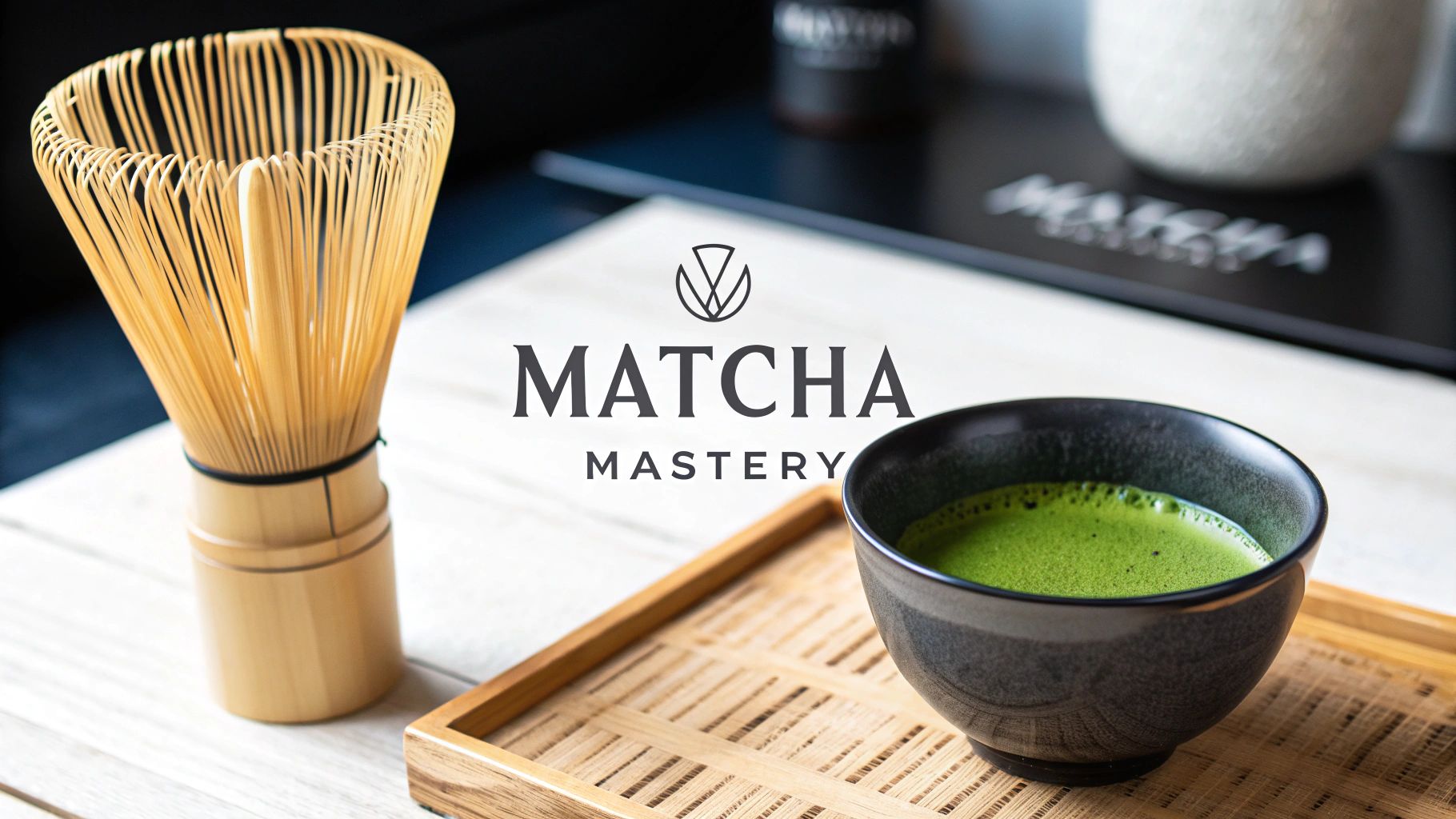At its heart, Japanese matcha is a finely ground powder made from green tea leaves that have been specially grown and processed. It’s a tradition deeply rooted in Japanese tea ceremonies, but today, it's also at the forefront of the wellness revolution. So what truly sets it apart from the green tea you might be used to?
When you brew regular green tea, you steep the leaves in hot water and then discard them. With matcha, you’re consuming the entire leaf, which means you get a much more concentrated dose of its nutrients, health benefits, and a uniquely vibrant flavour. This is your first step to understanding why matcha isn't just a tea—it's a complete wellness experience.
What Exactly Is Japanese Tea Matcha?
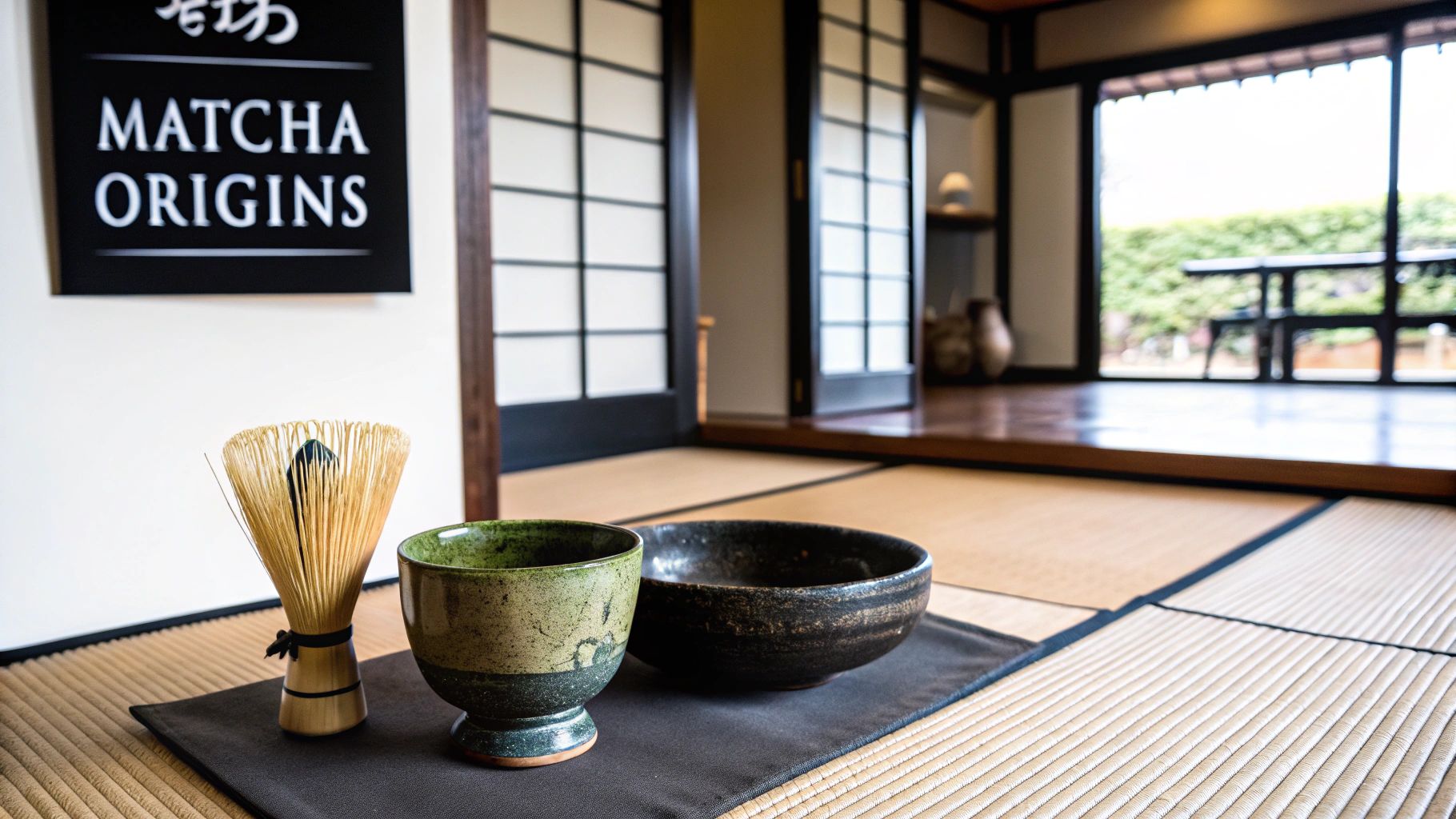
It’s easy to think of matcha as just another kind of green tea, but that’s like comparing a complex, single-origin espresso to a standard cup of filter coffee. They both start from a similar place, but the journey from plant to cup is worlds apart. This meticulous cultivation and production process is what transforms a simple tea leaf into a cultural and nutritional powerhouse.
Essentially, matcha is the whole-food form of green tea. Its story begins weeks before the harvest, when the Camellia sinensis tea plants are carefully shaded from direct sunlight. This step is the secret to what makes premium matcha, like Amatsu's, so exceptional.
The Power of Shade-Grown Leaves
This period of shade completely changes the leaf's chemistry. Starved of sunlight, the plant goes into overdrive producing chlorophyll, the pigment responsible for its deep green colour. This is why top-tier matcha has that stunning, almost electric green hue, while standard tea is often a duller olive.
But it’s not just about the colour. Shading also ramps up the production of amino acids, especially a remarkable compound called L-theanine. This is the source of matcha's complex, savoury flavour profile known as umami—that rich, brothy, and deeply satisfying taste that sets it apart.
By blocking the sun, farmers are essentially tricking the tea leaf, forcing it to create a profile that’s richer in nutrients, deeper in flavour, and more vibrant in colour. It’s this agricultural artistry that defines authentic Japanese tea matcha.
From Leaf to Powder
Once harvested, the leaves are quickly steamed. This crucial step stops any oxidation, locking in their brilliant colour and precious nutrients. Next, they are painstakingly de-stemmed and de-veined, leaving behind only the tender, nutrient-dense flesh of the leaf, called tencha.
This tencha is then slowly, almost meditatively, stone-ground into the micro-fine powder we recognise as matcha. The traditional stone-grinding method is deliberately slow to prevent heat from friction, which would otherwise scorch the delicate leaves and ruin their flavour.
The result is a powder so fine it can be suspended in water to create a creamy, frothy drink. When you drink matcha, you are consuming the whole leaf and all of its benefits—a difference you can explore further by comparing pure matcha vs green tea in our detailed guide. This careful, multi-stage process shows why matcha is so much more than a beverage; it’s a craft, and the foundation for every Amatsu blend.
The Cultural Heartbeat of Matcha
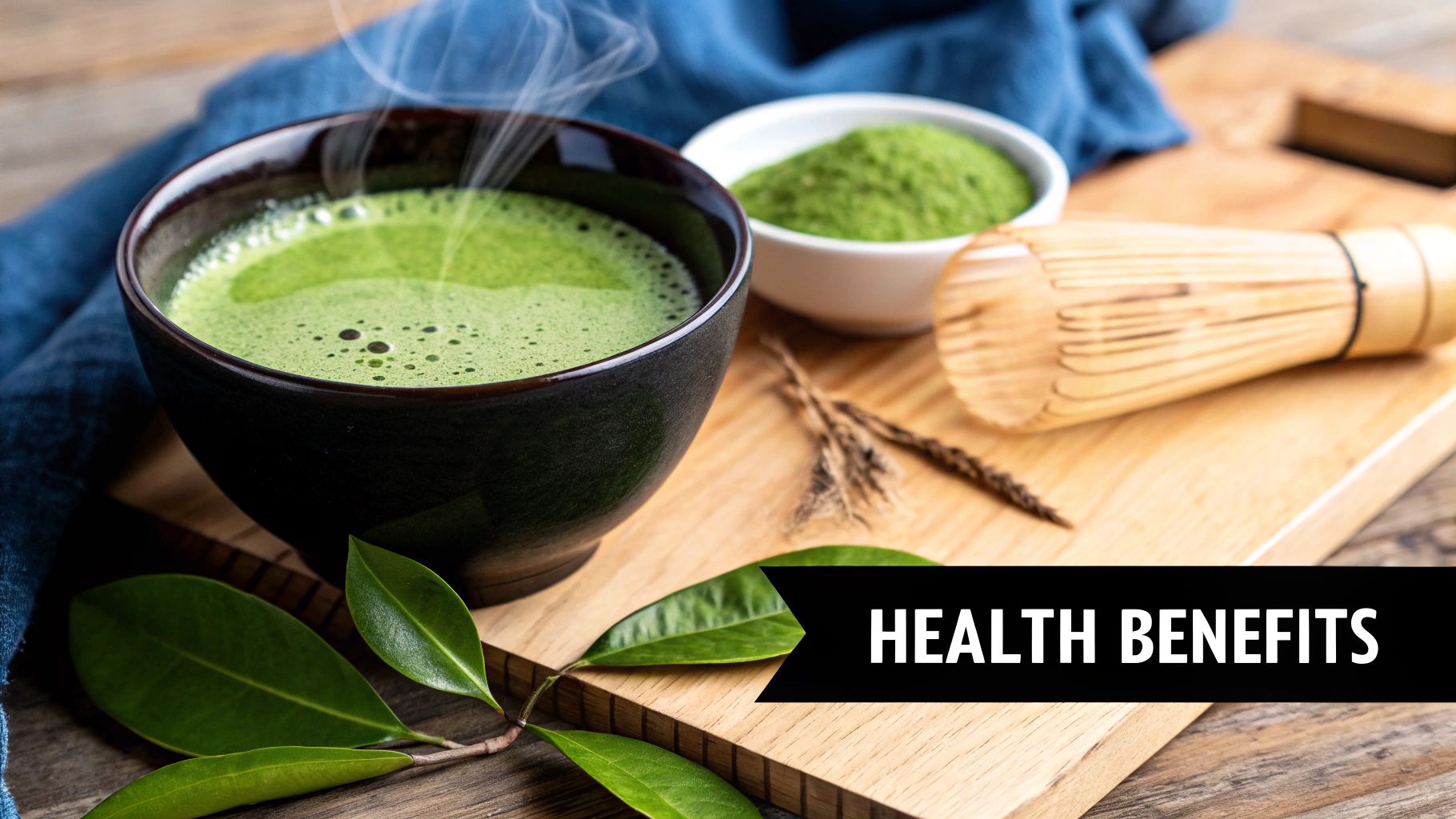
It’s easy to think of matcha as just another café trend, a colourful alternative to your usual latte. But the story of this vibrant green powder begins far from any modern high street, rooted instead in the quiet, contemplative world of ancient Zen Buddhist monasteries. Before it ever graced an influencer’s feed, matcha was a tool for spiritual clarity.
Centuries ago, monks realised that preparing and drinking matcha helped them stay focused yet calm during long meditation sessions. The very process of whisking the powder into a frothy, emerald liquid became a moving meditation, demanding a presence and intention that quieted the mind. This wasn't about quenching thirst; it was about carving out a moment of pure, uncluttered awareness.
Over time, this monastic practice slowly blossomed into the deeply refined and iconic Japanese tea ceremony, known as Chanoyu or Sadō (The Way of Tea).
The Philosophy of Chanoyu
At its core, the Japanese tea ceremony is much more than a precise method for making matcha. It's a spiritual practice guided by four principles that capture the very essence of Zen thought:
- Wa (和) Harmony: This is about creating a sense of unity between the host, guests, tea utensils, and the natural world, fostering a feeling of complete balance.
- Kei (敬) Respect: Respect flows through every gesture, shown to one another, to the tea itself, and to the beautiful objects used in the ceremony, like the delicate tea bowl (chawan).
- Sei (清) Purity: This principle touches on both physical and spiritual cleanliness, encouraging participants to cleanse their minds of daily clutter and worries.
- Jaku (寂) Tranquility: This is the ultimate aim. When the other three principles come together, a profound sense of calm settles over everything.
Chanoyu embodies a powerful concept called Ichigo Ichie—the idea that every meeting, every single ceremony, is a once-in-a-lifetime event. It’s a beautiful reminder to cherish the present, because that exact moment will never come again.
From Ancient Ritual to Modern Ritual
Knowing this rich history completely changes how you see a simple bowl of matcha. Suddenly, you're connected to a legacy of mindfulness passed down for nearly 1,000 years. The deliberate, graceful movements are all part of a practice designed to focus the mind and soothe the soul. If you’re curious about bringing this into your own life, you can explore the elements of the modern matcha tea ceremony.
This is the very heritage that we at Amatsu Matcha seek to honour. By sourcing exceptional, ceremonial-grade Japanese tea matcha, we provide a tangible link to this ancient tradition. When you prepare a bowl of Amatsu, you’re doing more than just making a healthy drink. You are stepping into a timeless ritual, inviting a moment of peace and intention into your modern day.
The Real Health Benefits of Matcha
While its history is fascinating, let's be honest: matcha's booming popularity comes down to its reputation as a wellness powerhouse. There's real substance behind the vibrant green colour. Matcha delivers tangible, science-backed health benefits that are perfect for a modern, proactive approach to wellbeing.
The secret is simple. With matcha, you consume the entire tea leaf, not just a watery infusion. This means you get a potent, concentrated dose of powerful plant compounds that are mostly lost when you brew a regular cup of green tea. The two main stars of the show are catechins and L-theanine.
Matcha isn’t just a drink; it’s a functional food. Every sip of an Amatsu blend delivers a symphony of compounds working in harmony to support your body and mind, from bolstering your antioxidant defences to sharpening your mental focus.
The Antioxidant Power of Catechins
Matcha is absolutely packed with a class of antioxidants called catechins. One in particular, epigallocatechin gallate (EGCG), gets most of the attention. Think of antioxidants as your body's personal security team, defending your cells against damage from free radicals—unstable molecules that contribute to ageing and chronic disease.
Because you’re consuming the whole, powdered leaf, you get a massively higher concentration of EGCG than from any other tea. This translates to serious benefits:
- Cellular Protection: EGCG is a master at neutralising harmful free radicals, protecting your cells from oxidative stress. This is the foundation of our Radiance blend, which pairs matcha's power with marine collagen for inside-out beauty.
- Metabolic Support: Studies suggest the catechins in matcha can give your metabolism a gentle nudge, helping to increase fat oxidation. It's a fantastic partner for a healthy diet and an active lifestyle.
- Immune System Support: The powerful antioxidant and anti-inflammatory properties found in matcha’s compounds also help to support a robust immune system.
This health-first mindset is a huge driver of matcha's growth, especially here in the UK. The demand is tied directly to the wider wellness movement, and market analysis suggests that between 2025 and 2030, the UK matcha tea market is projected to grow at a compound annual growth rate of around 8.3%. You can see more on this in this UK matcha market report.
Calm Energy and Focus from L-Theanine
Ever had that jittery, anxious buzz from a strong cup of coffee? Matcha offers the complete opposite experience, thanks to a rare amino acid called L-theanine. This incredible compound is the key to matcha's signature "calm alertness."
L-theanine works in perfect synergy with matcha's natural caffeine. Instead of a jarring spike followed by a crash, the caffeine is released slowly. At the same time, L-theanine encourages the production of alpha waves in the brain—the same ones associated with a state of relaxed, wakeful concentration. For a closer look, check out our guide on why matcha is great for sustained energy.
This unique one-two punch delivers:
- Sustained Energy: A gentle lift that keeps you going for hours, completely free of the jitters.
- Enhanced Focus: A noticeable improvement in concentration and mental clarity, perfect for deep work or creative pursuits.
- Reduced Stress: L-theanine has a naturally calming effect, helping to smooth out the rough edges of a busy day.
This makes matcha the ideal drink for anyone wanting to be productive and sharp without feeling wired. It’s exactly why we've designed functional blends like Amatsu’s Shrooms to amplify this cognitive benefit, and Strength to fuel physical performance, connecting ancient benefits to modern wellness goals.
Choosing the Right Matcha Grade for You
Stepping into the world of matcha can feel daunting when you see terms like ‘Ceremonial’ and ‘Culinary’ grade. Picking the right one simply comes down to how you plan to enjoy it.
Think of it like olive oil. You have your exquisite, cold-pressed extra virgin olive oil for drizzling, and your everyday olive oil for cooking. Both have their place.
Ceremonial Grade matcha is your "drizzling" oil. It's crafted from the youngest, most delicate tea leaves from the first harvest. The flavour is incredibly nuanced, smooth, and full of that coveted sweet umami. It’s meant to be savoured on its own, whisked with hot water.
Culinary Grade matcha, on the other hand, is your robust "cooking" oil. It comes from later harvests, giving it a bolder, more assertive taste. This stronger flavour is exactly what you need to cut through the richness of milk in a latte or the sweetness of a cake.
Comparing Ceremonial vs Culinary Matcha
To make the choice crystal clear, let's put them side-by-side.
| Feature | Ceremonial Grade Matcha | Culinary Grade Matcha |
|---|---|---|
| Tea Leaves | First-harvest, youngest leaves from the very top of the plant. | Later-harvest leaves, often a blend of second and third harvests. |
| Colour | A vibrant, electric emerald green. | A more subdued, often yellowish or brownish-green. |
| Texture | An exceptionally fine, silky powder, similar to talc. | A slightly coarser powder that doesn't dissolve as smoothly. |
| Taste Profile | Naturally sweet, with deep umami notes and a smooth, creamy finish. | Bolder and more astringent, with a slightly bitter taste. |
| Best Used For | Traditional tea preparation with only water. The base for all Amatsu blends. | Lattes, smoothies, ice cream, baking, and other recipes. |
One isn't "better" than the other—they are simply different tools for different jobs. At Amatsu, we use only premium Ceremonial Grade matcha as the foundation for all our blends, ensuring you get the best flavour and most potent benefits, no matter how you drink it.
When to Choose Each Grade
So, which one belongs in your kitchen cupboard?
-
For the Purist: If you're seeking a meditative moment with a traditionally prepared bowl of matcha, Ceremonial Grade is your only real option. Its delicate flavour is the experience. Amatsu Matcha’s Pure blend is a perfect example, designed for that authentic moment of focus.
-
For the Creator: If you're excited to whip up vibrant matcha lattes, green smoothies, or matcha-infused desserts, you might think you need Culinary Grade. However, using a high-quality Ceremonial Grade like Amatsu’s ensures a smoother, less bitter taste and a more vibrant colour in all your creations. It elevates your recipes from good to exceptional.
The way you prepare your matcha is central to the whole experience.
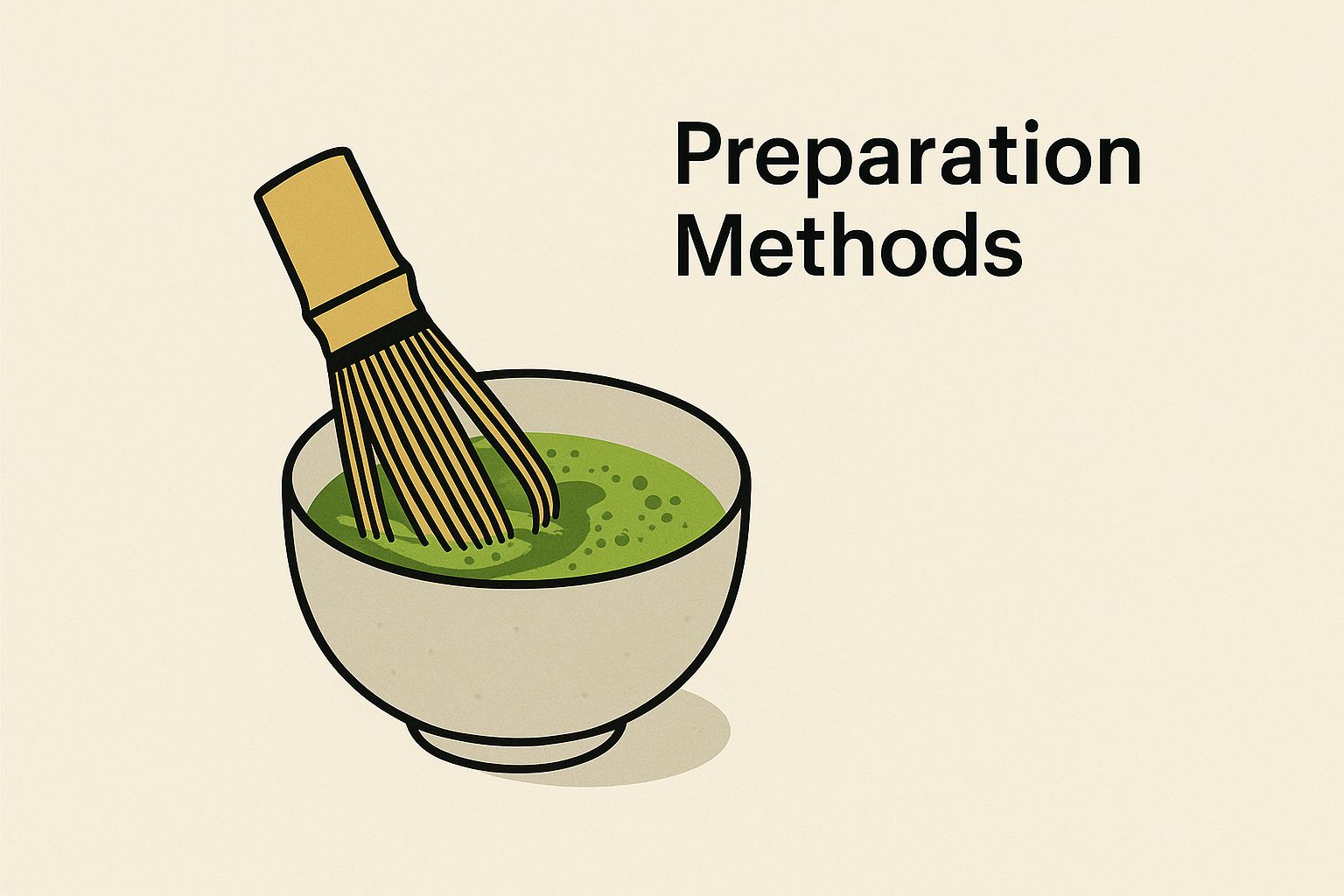
Ultimately, starting with a superior Ceremonial Grade gives you the versatility to enjoy this incredible green tea in all its forms—from a quiet, mindful ritual to a creative culinary adventure, without compromising on quality.
How to Make the Perfect Bowl of Matcha
Making a beautiful bowl of matcha is a small, rewarding ritual. Forget any ideas of it being complicated. With just a handful of simple tools and a bit of know-how, you can create your own pocket of calm right at home. The goal is to find a moment to be mindful and craft something special for yourself.
The traditional tools aren't just for show—they have a real job to do in creating that perfect bowl.
The Essential Tools of the Ritual
While you can make matcha without them, using the traditional implements elevates the experience and the final result.
- The Bamboo Whisk (Chasen): The heart of the operation. Its delicate prongs are designed to aerate the matcha, break up clumps, and whip up that signature creamy froth.
- The Tea Bowl (Chawan): A wide, flat-bottomed bowl that gives you space to whisk properly and is shaped to be cupped comfortably in both hands.
- The Bamboo Scoop (Chashaku): This elegant scoop is designed to measure the ideal amount of matcha for a single serving—usually one to two scoops.
Using these items transforms making tea into a more thoughtful process.
The magic of preparing matcha is rooted in its simplicity. By focusing on just three key things—sifting, water temperature, and whisking—you unlock a flavour and texture you just can't get any other way.
A Step-by-Step Guide to Perfection
Ready to create your own moment of matcha bliss? Following these simple steps will ensure you get a smooth, frothy, and delicious bowl every single time.
-
Sift Your Matcha: This is the non-negotiable secret to a clump-free brew. Gently push one to two chashaku scoops (about 1-2 teaspoons) of matcha through a small, fine-mesh sieve and into your chawan. This guarantees a silky-smooth texture.
-
Add Hot, Not Boiling, Water: This is crucial. Water that’s too hot will scorch the delicate tea, leaving you with a bitter taste. The sweet spot is around 80°C (175°F). Just boil the water and let it sit for a minute to cool down. Add about 60-70ml (roughly 2-3 ounces) of the hot water into the bowl.
-
Whisk with Intention: Hold the chawan steady and, using your chasen, start whisking vigorously in a quick ‘W’ or ‘M’ shape. Focus on the surface, keeping your wrist loose, to build a fine, creamy froth. This should only take about 20-30 seconds.
Once a lovely layer of foam appears, your perfect bowl of Japanese tea matcha is ready. For an even more detailed walkthrough, you can find extra tips in our complete guide on how to make matcha. Following this method ensures you get the absolute most from your high-quality tea, like Amatsu's Pure Ceremonial blend, allowing its naturally sweet and umami notes to shine.
Find Your Perfect Match with Amatsu
https://www.youtube.com/embed/xD7qUfSOGOE
Exploring the world of matcha is a personal journey. You've learned about its history, incredible health benefits, and the art of preparing it. Now, it's time to find the right matcha for you. The real goal isn't just to drink matcha; it's to find a blend that genuinely supports your wellness ambitions.
We created the Amatsu Matcha line to be more than just high-quality tea. Each blend is a carefully considered answer to a specific need, designed to turn your daily cup into a purposeful ritual.
Blends Created for Your Lifestyle
Whether you’re looking for sharper focus, a natural beauty boost, or extra help with your fitness goals, there’s an Amatsu blend made with you in mind. Each one starts with the same superb ceremonial grade matcha and is enhanced with functional ingredients to meet your needs.
-
For the Traditionalist - Amatsu Pure: If the quiet, meditative side of the tea ceremony calls to you, then Pure is your perfect match. This is our unadulterated, ceremonial grade matcha, best enjoyed simply with water to appreciate its complex umami flavour and smooth finish—ideal for a moment of calm and focus.
-
For a Youthful Glow - Amatsu Radiance: Looking to support your skin, hair, and nails from within? Radiance is specifically designed with premium marine collagen, pairing matcha's antioxidants with collagen’s building-block properties for a beauty ritual that works from the inside out.
-
For Enhanced Focus - Amatsu Shrooms: For those times you need to be at the top of your mental game, Shrooms is the answer. We’ve boosted this blend with functional mushrooms like Lion's Mane and Cordyceps, celebrated for supporting cognition and energy. It's the ultimate partner for deep work or creative pursuits.
-
For Physical Performance - Amatsu Strength: If you’re serious about your fitness and recovery, make Strength your ally. This blend is fortified with creatine to help support muscle power and endurance, making it a fantastic drink for before or after your workout.
Meeting the UK’s Growing Appetite for Functional Matcha
People no longer just want a tasty drink; they want beverages that do something. This demand for functional, high-quality matcha is growing fast in the UK.
The numbers don't lie. The UK matcha market is set to expand dramatically, from around USD 137.25 million in 2025 to a projected USD 517.96 million by 2035. That's an annual growth rate of about 12.83%. This incredible surge is fuelled by people seeking products that fit a wellness-first lifestyle, with powdered matcha already making up over 55% of the market.
At Amatsu, we’re not just watching this trend; we’re leading it. Our functional blends are our answer to this call for smarter, more effective wellness products that are also a genuine pleasure to drink.
Choosing the right matcha is about matching its unique benefits to your personal goals. It's about turning your daily cup into a deliberate act of self-care. Now that you understand what makes each Amatsu blend special, you can confidently pick the perfect partner for your wellness journey. If you're still exploring, read about why Amatsu Matcha is leading the functional wellness revolution in the UK.
Your Matcha Questions Answered
As you dive into the vibrant world of matcha, a few questions are bound to come up. We’ve gathered some of the most common ones we hear to give you clear, simple answers.
Let's clear up a few things so you can focus on the incredible experience ahead.
How Is the Caffeine in Matcha Different from Coffee?
The energy you get from matcha feels completely different from a coffee buzz. While matcha has caffeine, it’s also packed with an amino acid called L-theanine. This incredible compound encourages relaxation and mental focus, which beautifully balances the caffeine's stimulating effects.
This synergy is what gives you matcha's famous "calm alertness." You get a clean, sustained energy boost and sharper clarity that lasts for hours, without the nervous jitters or the dreaded afternoon crash so many of us get from coffee.
What Makes Matcha Different from Green Tea Powder?
This is a really important one. True Japanese matcha is made from tencha—tea leaves that have been carefully shade-grown for several weeks. This crucial step massively boosts the chlorophyll and L-theanine content, giving matcha its brilliant green colour and deep, savoury umami flavour.
Most generic "green tea powder" is simply ground-up sencha, a type of green tea grown in direct sunlight. The result is a powder that's often more bitter, has a duller colour, and contains far fewer of the beneficial compounds that make real matcha so special. This is why Amatsu uses only authentic, premium matcha.
When you drink matcha, you're consuming the entire leaf, so the quality of that leaf makes all the difference. The meticulous, shade-grown process isn't just about tradition; it's the very soul of matcha's unique character and potent benefits.
How Should I Store My Amatsu Matcha?
To protect your matcha's fresh flavour, powerful nutrients, and vivid green hue, shield it from its three greatest foes: air, light, and heat. Always keep it sealed in its original airtight tin and store it in a cool, dark spot like a kitchen cupboard.
If you're storing an unopened tin for a while, the fridge is a great option. Once you've opened it, it's best to enjoy your matcha within a few months to experience it at its absolute peak of freshness and taste.
Is It a Waste to Use Ceremonial Grade for Lattes?
Traditionally, yes. Ceremonial Grade matcha is celebrated for its exceptionally delicate flavour, which is best enjoyed with water alone. However, using a high-quality Ceremonial Grade, like the one found in all Amatsu blends, elevates any recipe. It results in a smoother, less bitter, and more vibrant latte than what you'd get with a lower-quality Culinary Grade, making it a worthy upgrade for any matcha lover.
Ready to put your new knowledge to the test and find your perfect functional blend? Explore the full Amatsu Matcha collection and start your journey into a world of flavour, focus, and modern wellness. Find your perfect match today.
Read more
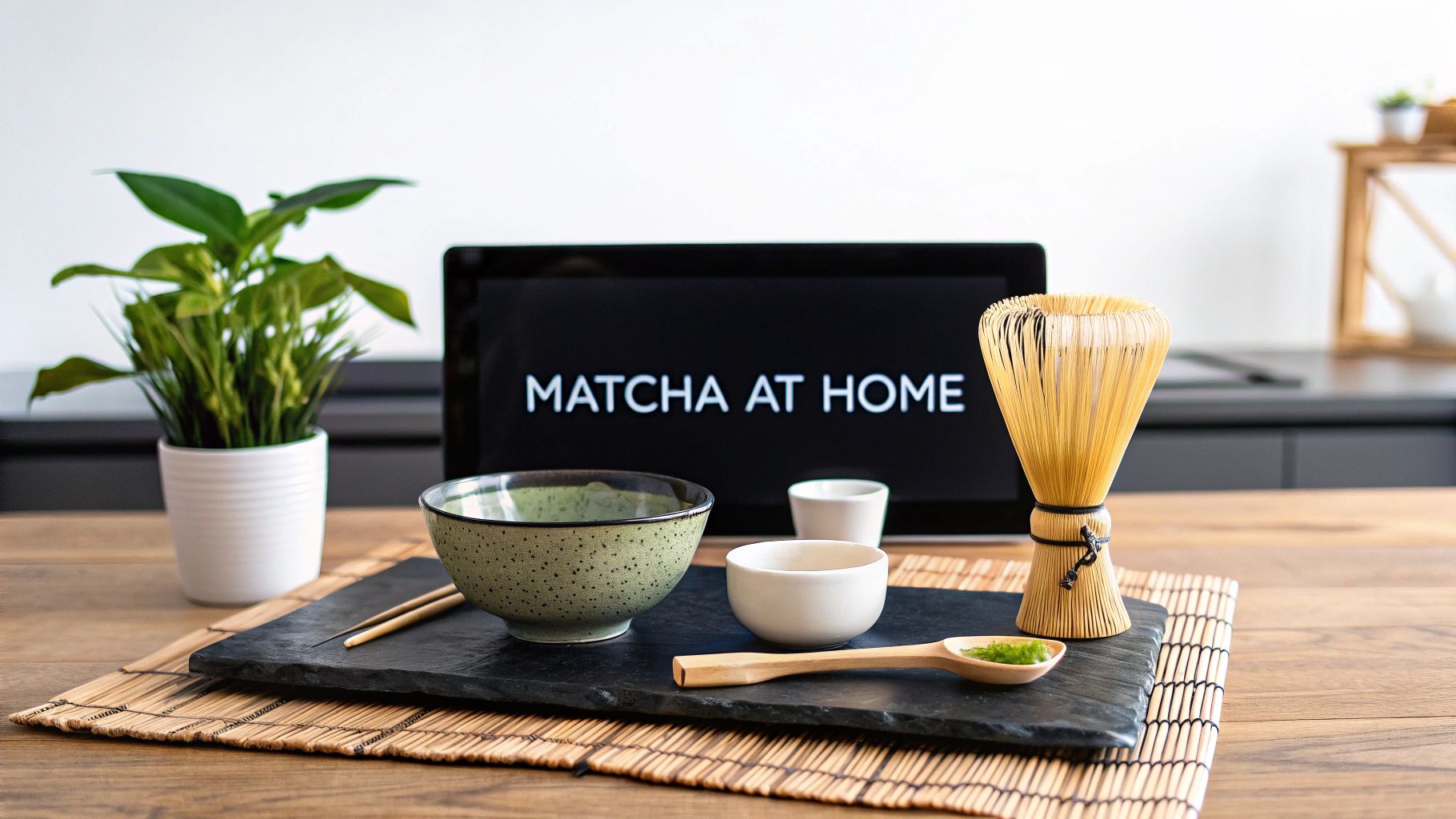
Create an authentic tea ceremony matcha experience at home. Our guide covers essential tools, techniques, and the best matcha for a mindful, perfect cup.
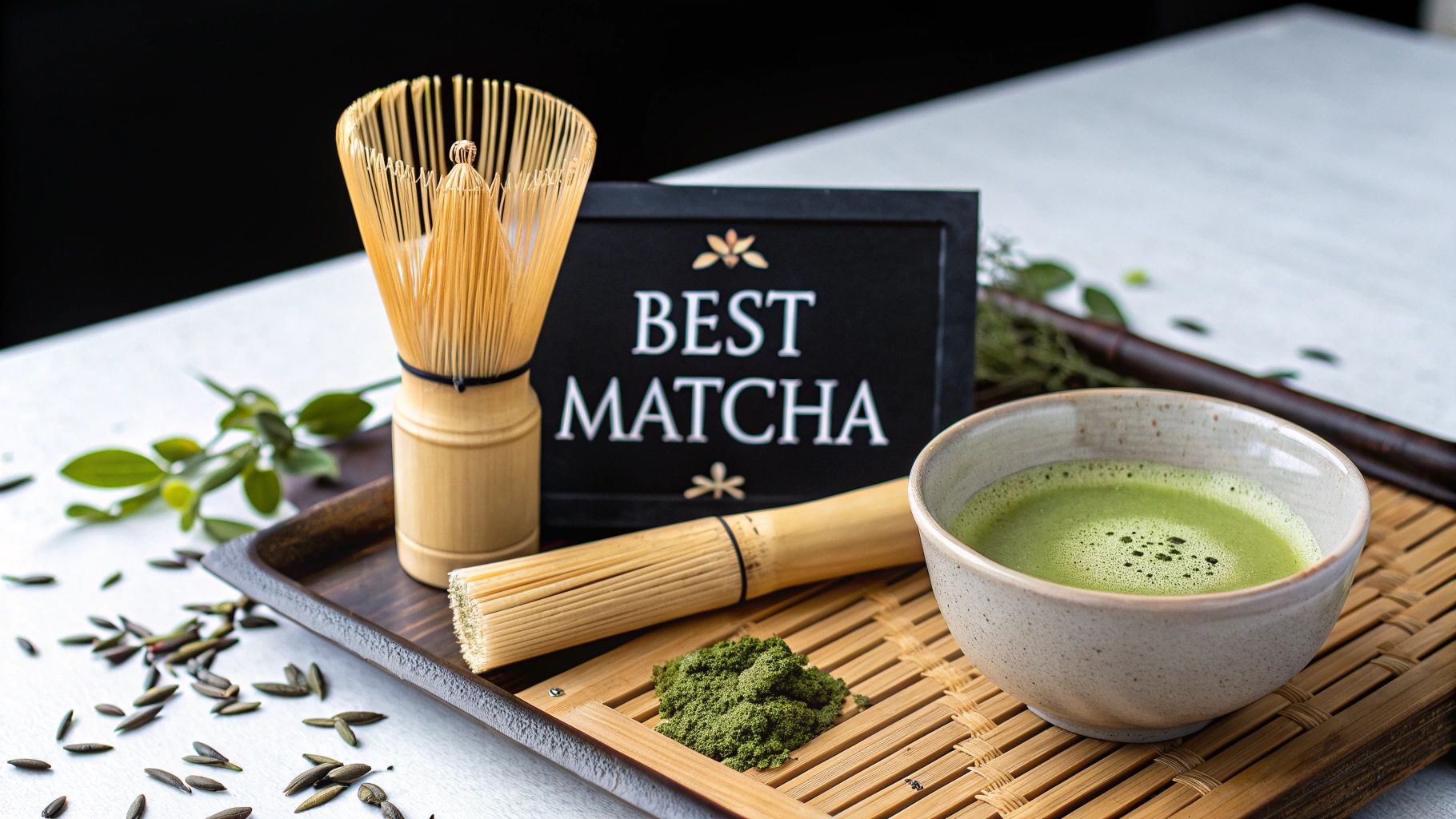
Discover how to choose the best ceremonial grade matcha. Learn tips, benefits, and brewing secrets for your perfect, smooth cup of matcha.
